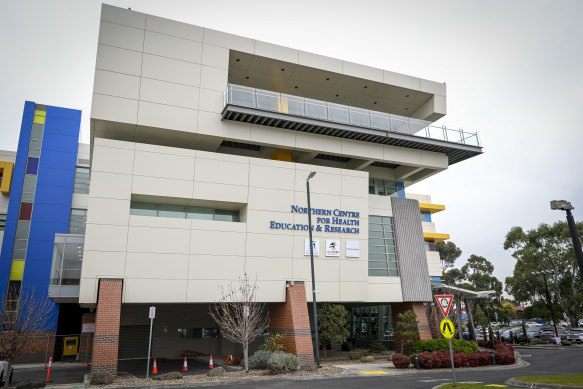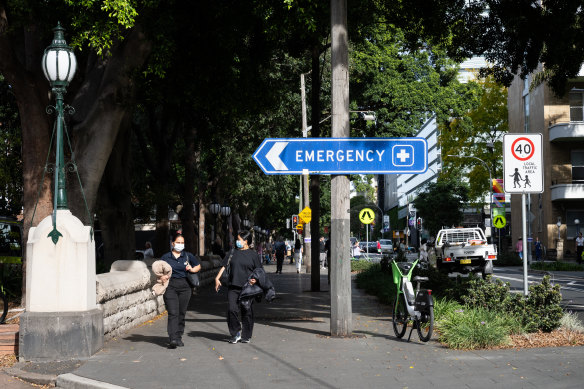He said while the state government had taken important steps to reduce the use of seclusion and restraint in hospitals, there had not been the required investment to de-escalate situations.
Northern Health reported the highest number of violent incidents in the state, with staff at the major hospital recording 3649 incidents, up from 643 incidents the year before.
A spokeswoman for the health service said the rise in incidents was due to the increased size of its workforce as a result of Northern Health becoming a designated mental health service. She said there had also been a push to promote the reporting of occupational violence.
“Whilst the number of [occupational violence and aggression] reported in the last financial year has increased, the percentage of those resulting in injury or illness has declined due to training and early intervention,” she said.
“We continue to work on ways to reduce the number of incidents to protect the safety and wellbeing of our staff, patients and visitors.”
Australian Nursing and Midwifery Federation Victorian Branch acting secretary Madeleine Harradence said violence and aggression was an issue across all clinical areas, with hot spots located in emergency departments and mental health services.
“The time for awareness campaigns is over,” she said. “It is time for real action to ensure nurses and midwives are safe during their shift and go home to their families and loved ones.”

Northern Health, which runs the Epping Hospital, had the most violent incidents. Credit: Eddie JIm
The union has created a plan to address violence in the workplace – which includes boosting security, rolling out risk assessments of patients and improving training – and is calling on the Health Department to roll it out across the state’s public healthcare services.
Harradence urged the Allan government to make health a regulated industry under the Occupational Health and Safety Act’s regulations, similar to the male-dominated industries of mining and construction.
“Then we would start to see prosecutions against hospitals and aged care services for failing to protect their nurses and midwives,” she said.
A mental health nurse, who did not want to be identified for fear of losing her job, said the level of violence in hospitals was the worst she had seen during her 35-year career.
“It has escalated to being out of control,” she said.
She recently witnessed a patient punching her colleague in the face, grabbing her by the hair and throwing her across a courtyard.

Use of methamphetamines is contributing to the increasing attacks on nurses, midwives and doctors. Credit: Fairfax
A few years ago, she witnessed another violent attack that left a colleague concussed and suffering from whiplash and eight broken teeth.
She has also been injured: three years ago she tore the ligaments in her knee, and had to go on WorkCover, after being kicked by a patient while they were strangling another nurse.
“You become very desensitised to aggression,” said the nurse.
She criticised the state government for reneging on a promise to create 800 jobs across Victoria’s mental health services, saying it had left the sector under-resourced.
She said the drug methamphetamine, or ice, was also fuelling the rise in incidents as it could make patients aggressive and resistant to sedatives.
“We give them sedatives and it usually has no effect and their only defence is violence,” she said.
Hospitals across the state are rolling out a range of initiatives to try to stem the violence, including training for staff to help them identify and intervene early during high-risk situations and rolling our duress alarms for staff working out in the community. One regional hospital has rolled out “behaviour of concern” scores which are uploaded onto patients’ electronic records.
Melbourne Health, which runs the Royal Melbourne Hospital, recorded 2197 incidents last financial year, which was an improvement on the 2412 incidents logged by staff the year before.
An average of 9 per cent of incidents at Victorian hospitals resulted in an injury, illness or medical condition.
Australian College for Emergency Medicine federal president Stephen Gourley said violence and aggression was becoming increasingly common in emergency departments.

Ambulance ramping and delays in emergency department treatment contribute to the rising violence against hospital staff. Credit: AFR
He said it was fuelled by excessively long wait times, patient frustration and ambulance ramping. Patients who are intoxicated with alcohol or other drugs can be difficult and dangerous to manage, according to Gourley.
“Violence in EDs has significant effects on both the physical and psychological health of hospital emergency department staff, as well as significant economic and social costs,” he said.
Shadow health minister Georgie Crozier said Labor had failed in its promise to stamp out violence and aggression in hospitals.
Loading
“Under the Allan Labor government, amid the chaos in our hospitals, the number of attacks on Victorian healthcare workers continues to rise,” she said.
A government spokesman said nurses, midwives, doctors and allied health professionals deserved a safe environment, free from any physical or verbal violence and aggression.
“As employers, individual health services and their boards have a legal responsibility for maintaining a safe workplace for staff – the Department of Health supports each to ensure they are meeting their obligations to their workforce,” she said.
She said the Allan government had invested more than $47 million on occupational violence training and initiatives since 2015. It has also brought in new laws that make injuring an emergency worker a category 1 offence.
A WorkSafe spokeswoman said employers must do everything possible to prevent work-related violence, including encouraging workers to report incidents.
“No matter the situation, incidents of violence and aggression should never be seen as ‘part of the job’ for any healthcare worker,” she said.
Start the day with a summary of the day’s most important and interesting stories, analysis and insights. Sign up for our Morning Edition newsletter.

